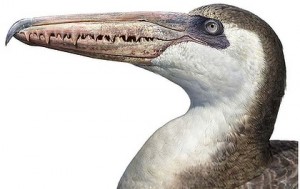A FOSSIL uncovered on a Melbourne beach belonged to a giant prehistoric bird with a five-metre wing span and serrated beak, scientists report.
The 5 million-year-old lower leg bone is the first evidence the ancient sea bird once soared across Australia’s skies.
A Museum Victoria palaeontologist, Erich Fitzgerald, who led analysis of the specimen, said the discovery meant the species, Pelagornis, which lived for more than 50 million years before becoming extinct about 2.5 million years ago, existed on all continents.
The ancient feathered creatures, known as bony-toothed birds for the sharp, teeth-like serrations along their beak, was the largest flying animal to exist on Earth after the extinction of Pterosaurs, a flying reptile that lived during the time of the dinosaurs, 65 million years ago.
”The wing span of these birds was as great as the height of a giraffe,” Dr Fitzgerald said.
The small leg bone was uncovered on a Museum Victoria field trip to Beaumaris, where fossils of ancient seals, dugongs and sharks the size of a city bus were found in 2004.
The specimen remained unstudied until Museum Victoria fossil bird expert and PhD student Travis Park and University of Adelaide researcher Trevor Worthy joined Dr Fitzgerald to investigate last year.
”When Pelagornis was soaring the skies of the world, our hominid ancestors were alive and well in east Africa,” Dr Fitzgerald said.
But after more than 100 years of research their closest ancestors remain ”hotly debated” among scientists. ”Although they have some characteristics that suggest relation to pelicans, other features hint at affinities to albatrosses,” he said.
 Dr Erich Fitzgerald with the five million-year-old bone of giant bony-toothed bird Pelagornis. Photo: Museum Victoria
Dr Erich Fitzgerald with the five million-year-old bone of giant bony-toothed bird Pelagornis. Photo: Museum VictoriaWhile the exact cause of the creature’s demise was unknown, environmental factors were believed to have played a role, said Dr Fitzgerald, whose findings are published in the Journal of Vertebrate Paleontology. ”We know that about the time the animal went extinct there were some major shifts in the Earth’s climate as it entered the ice ages.”
Courtesy: Nicky Phillips



 June 28th, 2012
June 28th, 2012  riffin
riffin 
 Posted in
Posted in 